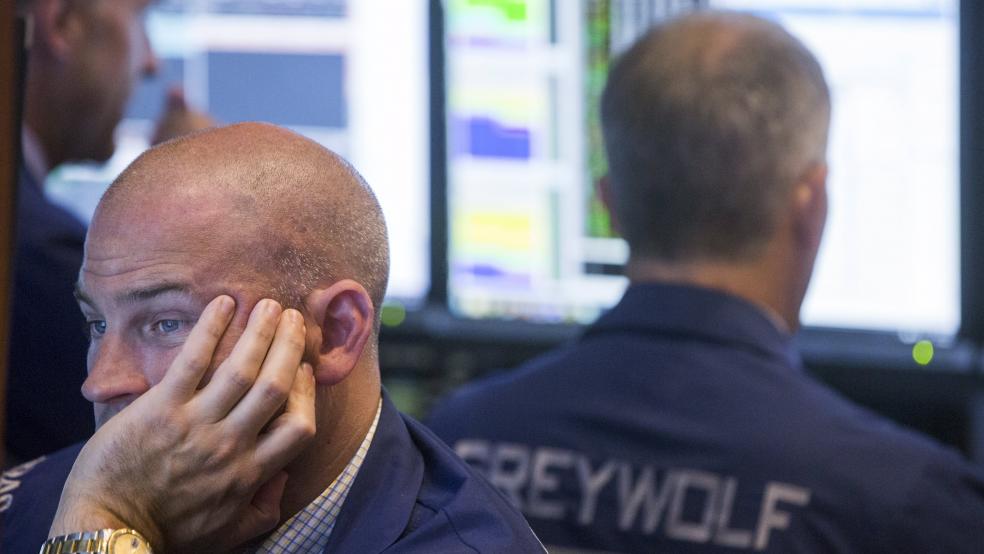You can’t tell it from latest market action, but investors remain on edge heading into the first potential rate hike from the Federal Reserve in nearly a decade. And the evidence suggests the momentum is only going to get worse as investors find fewer and fewer stocks attractive at these price levels.
Look beyond the headline gains driven by a rally in oil prices and you’ll find evidence that investors are abandoning stocks in droves, suggesting an incipient downtrend is underway. The percentage of S&P 500 stocks in uptrends actually fell 4 percent to 53.4 percent despite Monday's overall gain. This is down from a high of 72.2 percent back in early November.
Declining issues outpaced advancing issues on the NYSE Monday by 2,339 to 834, while down volume accounted for 62 percent of total volume. And a whopping 632 issues on the NYSE hit a new 52-week low vs. just five new highs. That's jaw dropping. And it represents nearly 20 percent of all issues that trade on that exchange.
Related: 10 Ways the Fed's Looming Rate Hike Touches You
According to Jason Goepfert at SentimenTrader, going back to 1962 that's nearly an unprecedented event. The only other periods that were even close were May 2004 and July 2007, both of which were followed by "unsettled" markets for months.
With fewer than 27 percent of the stocks in the S&P 500 rising, despite its gain of nearly 0.5 percent Monday, such a narrow rise has only been seen four other times in the last 50 years: October 1979, August 1981, October 1987 and November 2007. The 2007 occurrence came just before a feeble rebound attempt that represented the last chance to bail out of the housing-bubble-boosted stock market before the house of cards came down.
Bond market weakness remains center stage as well, with issues in the high-yield corporate bond market now spreading to other credit areas, such as investment-grade bonds. Yet another high yield credit fund — the third in recent days — ran into problems Monday as Lucidus Capital liquidated its $900 million portfolio and will return capital to investors.
Related: Why Raising Interest Rates Isn’t as Easy as It Sounds
Wall Street has done its best to calm raw nerves, with Morgan Stanley noting that the high-yield bond market is a declining share of the overall bond market and that cash levels at high-yield mutual funds is at its highest level since 2012. But the cavalcade of issues in play are hard to dismiss.
The economic expansion is getting long in the tooth, at 78 months, and is already longer than 29 of the last 33 expansions since 1854. The drag from low energy prices, a stronger dollar and the expected rise in interest rates are set to push S&P 500 earnings down for the third consecutive quarter, something that hasn't happened since the financial crisis. And the expected rise in interest rates, the vulnerability of high-cost U.S. shale oil producers and the drop in corporate profitability will likely push up bond default rates — providing yet another reason for bond investors to sell into a thin market with light volumes.
Related: The 3 Biggest Winners from the Fed’s Coming Rate Hike
So all eyes are, of course, turning to Wednesday's "hike/no hike" decision from the Federal Reserve. Expectations are for a 25 basis point increase in the short-term Federal Funds policy rate — up from nearly 0 percent now. Focus will be on the updated summary of economic projections, including the "dot plot" of interest rate expectations, for clues as to the pace of any subsequent rate hikes in 2016.
There is growing chatter that the Fed will soon have to start cutting rates again, with more than half of the 65 economists surveyed by The Wall Street Journal seeing rates back near 0 percent in the next five years. Ten expect rates in negative territory. Their concern centers on the fact that no major central bank has been able to raise interest rates and keep them high since the financial crisis and that the Fed has never waited this long into the business cycle to start tightening policy.
The bottom line: The odds of a policy misstep from the Fed are high and rising at a time when stock and bond markets are fragile and vulnerable. Investors should be thinking of protection and wealth preservation, not chasing flashy moves by tech high-fliers Netflix and Amazon.






